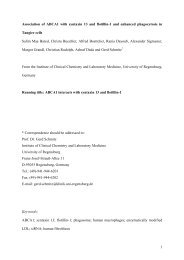SUNDAY, DECEMBER 4- Late Abstracts 1 - Molecular Biology of the ...
SUNDAY, DECEMBER 4- Late Abstracts 1 - Molecular Biology of the ...
SUNDAY, DECEMBER 4- Late Abstracts 1 - Molecular Biology of the ...
Create successful ePaper yourself
Turn your PDF publications into a flip-book with our unique Google optimized e-Paper software.
<strong>SUNDAY</strong><br />
2006<br />
Perilipin, Moesin and Microtubule Dependence <strong>of</strong> Lipid Droplet Clustering and<br />
Dispersion.<br />
D. Orlicky 1 , A. Stefanski 2 , B. Chong 2 , J. Monks 2 , C. Monks 3 , J. L. McManaman 2 ; 1 Pathology, UC<br />
Denver, Anschutz Medical Campus, Aurora, CO, 2 Ob/Gyn, UC Denver, Anschutz Medical<br />
Campus, Aurora, CO, 3 Intelligent Imaging Innovations, Inc., Denver, CO<br />
Cytoplasmic lipid droplets (CLD) function in storage, trafficking and secretion <strong>of</strong> lipids as well as<br />
a depot for fatty acid signaling precursors. Perilipin 1, <strong>the</strong> primary CLD binding protein in<br />
adipocytes, is thought to contribute to CLD trafficking by directing fragmentation <strong>of</strong> CLD into<br />
smaller droplets, making <strong>the</strong> lipids more enzymatically available. To study <strong>the</strong> role <strong>of</strong> perilipins in<br />
mediating intracellular CLD trafficking we used stable ectopic expression <strong>of</strong> perilipin 1, or<br />
truncated perilipin 1, in HEK293 cells. Expression <strong>of</strong> ei<strong>the</strong>r full-length or C-term perilipin 1<br />
(amino acids 198-517) initiated formation <strong>of</strong> single, dense CLD clusters that localize near <strong>the</strong><br />
microtubule organizing center (MTOC). Using live-cell imaging, we showed <strong>the</strong>se clustered CLD<br />
became fragmented and moved to <strong>the</strong> periphery <strong>of</strong> <strong>the</strong> cell in response to isoproterenol or<br />
forskolin activation <strong>of</strong> adenylate cyclase- which has previously been shown to regulate PKAmediated<br />
phosphorylation <strong>of</strong> perlipin 1. We fur<strong>the</strong>r show that nocodozole disruption <strong>of</strong><br />
microtubules could inhibit this process, while staurosporine blockage <strong>of</strong> PKA activity disrupted<br />
dispersion, but not <strong>the</strong> initial fragmentation <strong>of</strong> <strong>the</strong> CLD cluster. Finally, siRNA knockdown <strong>of</strong> <strong>the</strong><br />
cortical actin-binding protein, moesin, prevented dispersed CLD from reforming dense clusters<br />
when isoproterenol was removed. These data suggest a model in which CLD clustering and<br />
dispersion are mediated by both microtubules and actin, and trafficking is controlled by PKAphosphorylation<br />
<strong>of</strong> perilipin 1.<br />
2007<br />
Netrin-1-induced axon branching <strong>of</strong> cerebral cortical neurons requires DCC and lipid raft<br />
integrity.<br />
H. Matsumoto 1 , M. Nagashima 1 ; 1 Department <strong>of</strong> Anatomy, Faculty <strong>of</strong> Medicine, Saitama Medical<br />
University, Saitama, Japan<br />
A multifunctional axon guidance cue netrin-1 is known to induce axon branching in developing<br />
cerebral cortical neurons <strong>of</strong> mammals. In this study we investigated whe<strong>the</strong>r netrin-1-induced<br />
cortical axon branching involves DCC (deleted in colorectal cancer; one <strong>of</strong> known receptors for<br />
netrin-1) and lipid rafts (cholesterol- and sphingolipid-enriched membrane microdomains),<br />
employing dissociated cortical neurons prepared from neonatal Syrian golden hamsters.<br />
Stimulation <strong>of</strong> neurons by netrin-1 caused an increase in <strong>the</strong> number <strong>of</strong> branch points along <strong>the</strong><br />
primary axons, which is in consistent with previous reports. We <strong>the</strong>n observed that this increase<br />
was attenuated by application <strong>of</strong> a neutralizing antibody against DCC to <strong>the</strong> culture. Attenuation<br />
<strong>of</strong> netrin-1-induced axon branching was also caused by disruption <strong>of</strong> lipid rafts, while<br />
association <strong>of</strong> DCC to lipid rafts was revealed by Western blot analysis. These data indicate a<br />
significant contribution <strong>of</strong> DCC to, and requirement <strong>of</strong> lipid raft integrity for, <strong>the</strong> promotion <strong>of</strong><br />
cortical axon branching caused by netrin-1. Fur<strong>the</strong>rmore, <strong>the</strong> data suggest <strong>the</strong> possibility that<br />
association <strong>of</strong> DCC with lipid rafts is involved in netrin-1-induced axon branching. (Supported by<br />
Grant-in-Aid for Scientific Research (C) No. 23590225 from Japan Society for <strong>the</strong> Promotion <strong>of</strong><br />
Science.)
















